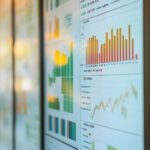Zennemis – Data Analytics Modernization. Did you know that businesses can make decisions 25% faster with modern data analytics? In today’s fast world, using data well is key to staying ahead. Companies face old system challenges, but new tech from Amazon, Microsoft, and Google helps.
These tools make data work faster and easier. They help solve problems of slow reports and manual data work.
By focusing on data analytics modernization, we can see market trends and customer needs better. Working with experts helps us understand our data and choose the best way to update it. Tools like RavenVISION and Caylent’s AWS solutions make it easier to grow and get insights quickly.
In this section, we’ll see why updating old systems is important. It opens up new chances in data analytics. This leads to better, smarter decisions based on data.
What is Data Analytics Modernization?
Data analytics modernization is key in today’s fast-changing business world. It’s about updating how we manage and analyze data to meet new needs. We move from old systems to new ones that support advanced analytics like machine learning and AI.
Defining Data and Analytics Modernization
Data analytics modernization is about improving our data systems to handle more data. Today, we deal with different types of data, from social media to customer feedback. This calls for a new approach to data, making it easier to use and analyze.
Importance of Modernizing Legacy Systems
Legacy systems often create data silos, making modernization essential. Old systems slow down our ability to get insights quickly. Moving to cloud or hybrid solutions improves our decision-making and adaptability.
A good modernization plan helps us combine different data sources smoothly. This tackles today’s data challenges and prepares us for better data use.
Benefits of Data Analytics Modernization
Data analytics modernization brings many benefits to an organization. It improves performance and growth. It’s important to use multiple data sources and real-time analytics to succeed today.
Enhanced Scalability and Flexibility
Modern data solutions make scaling easier by moving to the cloud. This lets us grow our operations smoothly. It’s key to quickly adapt to new data and customer needs.
Using data lakes helps store lots of data affordably. This solves old data processing problems.
Improved Decision-Making Processes
Data analytics modernization helps make better decisions faster. It gives us timely, accurate insights. This lets us make quicker, smarter choices with real-time data.
As costs go down and data quality improves, leaders get a better view of their world. This helps them make informed decisions.
Fostering a Data-Driven Culture
Creating a data-driven culture is vital. It lets employees use data on their own. This change helps us move from guessing to using data for decisions.
This shift boosts our work efficiency. It’s a big step forward for our operations.
Challenges in the Data Analytics Modernization Journey
Starting our data analytics modernization journey comes with many challenges. The fast growth of data is a big problem for old systems. We need to change how we manage data to make the most of new data tools.
Exponential Growth of Data Volumes
Data is growing fast, putting a lot of pressure on our systems. We must update our systems to handle this big change. This way, we can manage today’s data well and be ready for more in the future.
Eliminating Data Silos
Data silos are a big problem in modernizing data. They happen when different systems in our company make it hard to share data. We need to create one place for all data to make it easier to use and share, helping us make better decisions.
Addressing Skill Gaps in the Workforce
Another big challenge is the lack of skills in our team. As we move to new data tools, our team might need more training. By teaching our team about data, we can make our company more data-smart.
Strategies and Approaches for Data Adaptation
In today’s fast-changing digital world, we must tackle data analytics modernization with smart strategies. We start by creating a detailed data strategy. This plan is key to managing, integrating, and analyzing data to meet our goals.
Developing a Comprehensive Data Strategy
A strong data strategy is the foundation for modernization success. We must outline how we collect, process, and analyze data. This strategy guides us in using data to boost efficiency and make better decisions.
Implementing Modern Data Architecture
Then, we move to setting up modern data architecture. Cloud platforms offer scalability and flexibility, handling big data without the need for old, expensive hardware. This setup cuts costs and makes real-time analytics possible, giving us deeper insights into customer behavior.
Employing Advanced Analytics Tools
Lastly, we use advanced analytics tools. These include AI and machine learning, helping us get valuable insights from our data. By automating tasks like data integration, we improve our analysis skills. This keeps us ready to meet changing business needs.
Conclusion
Data analytics modernization is more than a trend; it’s a must for staying ahead in today’s data-rich world. We face many hurdles, like adopting new tech and overcoming internal barriers. But, modernizing is key to unlocking data’s full power, leading to smarter decisions and a data-first culture.
The journey to modernization is not easy, with challenges like poor tech use and disorganized data. Yet, with strategic planning and teamwork, we can overcome these. Getting leadership support and improving data skills are crucial. This approach will help us stay ready for the future and fully use data’s power.
By focusing on good data management and analytics, we can tackle future challenges and seize new chances. We’ll improve our results, enhance customer experiences, and achieve top-notch operations. Let’s see data modernization as a core part of our digital journey.
FAQ
What is data analytics modernization?
Data analytics modernization means updating an organization’s data systems. It moves from old systems to new cloud-based ones. This change supports advanced analytics and makes operations more agile and efficient.
Why is it important to modernize legacy systems?
Updating old systems is key because they often lead to data silos. These silos block good decision-making. New systems help integrate data smoothly, improve insights, and let companies quickly adapt to market changes.
What are the benefits of data analytics modernization?
Modernizing data analytics brings many benefits. It makes systems more scalable and flexible. It also improves decision-making with real-time insights. Plus, it helps create a culture where employees can use data well.
What challenges do organizations face during the data analytics modernization journey?
Companies face big challenges like data growing too fast and data being split up. They also struggle with a lack of skills in their teams. This might need training on new tools and tech.
What strategies should we employ for effective data modernization?
To modernize data well, create a detailed data strategy. Use modern data architecture like cloud platforms. Also, use advanced analytics tools to improve analysis and automate governance.
How can we ensure future readiness through data analytics modernization?
To be ready for the future, plan data modernization carefully. Adopt new technologies and practices. Also, build a culture that values data-driven insights and being adaptable.




